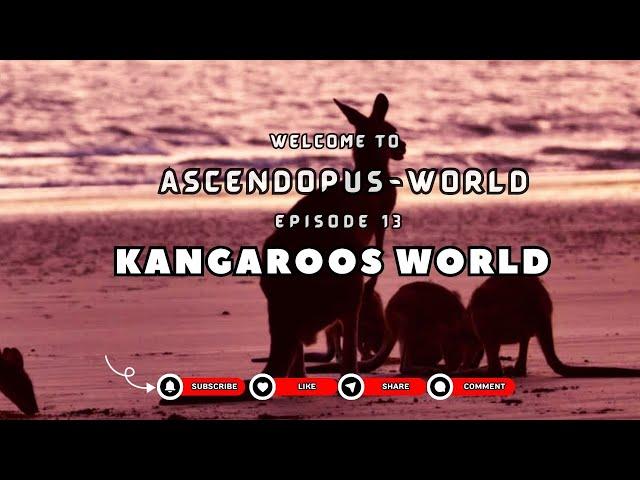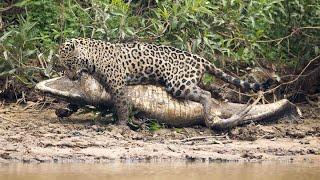
Episode 13: Creatures of Earth I Kangaroo World I @Ascendopus-World
#nature #naturelover #creature #relaxationmusic #relaxation #earth #kangaroo #kangarooaustralia
The Kangaroo: An Icon of Australian Wildlife
The kangaroo, an iconic symbol of Australia, captivates both scientists and nature enthusiasts with its unique characteristics and role in the ecosystem. Belonging to the family Macropodidae, which translates to "big foot," kangaroos are renowned for their distinctive mode of locomotion—hopping. This form of travel, powered by their powerful hind legs, allows kangaroos to cover long distances efficiently, a crucial adaptation for survival in Australia's often harsh and arid environments.
Among the various kangaroo species, the Red Kangaroo (Macropus rufus) stands out as the largest, with males reaching up to 2 meters in height and weighing over 90 kilograms. Other notable species include the Eastern Grey Kangaroo (Macropus giganteus) and the Western Gray Kangaroo (Macropus fuliginosus). Each species exhibits unique adaptations to its specific habitat, reflecting the diverse Australian landscape.
Kangaroo physiology is well-suited to their environment. Their long, muscular hind legs are specialized for hopping, which conserves energy, while their large, prehensile tail provides balance and support. These features, coupled with their varied fur colors—ranging from grey to reddish-brown—help them blend into their surroundings, offering camouflage from predators.
Socially, kangaroos live in groups called mobs, which are generally matriarchal. The mob structure facilitates protection and social interaction among members. Kangaroos are also marsupials, meaning that after birth, their underdeveloped young, or joeys, continue to develop in the mother’s pouch—a unique feature of their reproductive strategy.
Ecologically, kangaroos play a vital role in maintaining the balance of their habitats. Their grazing helps control vegetation growth, which can promote biodiversity by allowing various plant species to thrive. Additionally, their droppings contribute to soil fertilization, supporting the broader ecosystem.
Despite their robust presence, kangaroos face threats from habitat destruction, climate change, and human activities. Conservation efforts are crucial to mitigate these impacts and ensure the survival of these remarkable animals. Protecting their habitats and managing population numbers through regulated culling are essential steps in sustaining kangaroo populations.
In summary, the kangaroo is not just a symbol of Australia but a fascinating subject of study due to its unique adaptations, social behavior, and ecological importance. Efforts to conserve and understand these marsupials continue to be vital for maintaining the biodiversity and health of their natural environments.
World Kangaroo Day was held on Sunday, 24 October 2021. WKD is a day to celebrate, honour and respect one of the world’s great icons and recognise the importance of kangaroos to Australia.
The Kangaroo: An Icon of Australian Wildlife
The kangaroo, an iconic symbol of Australia, captivates both scientists and nature enthusiasts with its unique characteristics and role in the ecosystem. Belonging to the family Macropodidae, which translates to "big foot," kangaroos are renowned for their distinctive mode of locomotion—hopping. This form of travel, powered by their powerful hind legs, allows kangaroos to cover long distances efficiently, a crucial adaptation for survival in Australia's often harsh and arid environments.
Among the various kangaroo species, the Red Kangaroo (Macropus rufus) stands out as the largest, with males reaching up to 2 meters in height and weighing over 90 kilograms. Other notable species include the Eastern Grey Kangaroo (Macropus giganteus) and the Western Gray Kangaroo (Macropus fuliginosus). Each species exhibits unique adaptations to its specific habitat, reflecting the diverse Australian landscape.
Kangaroo physiology is well-suited to their environment. Their long, muscular hind legs are specialized for hopping, which conserves energy, while their large, prehensile tail provides balance and support. These features, coupled with their varied fur colors—ranging from grey to reddish-brown—help them blend into their surroundings, offering camouflage from predators.
Socially, kangaroos live in groups called mobs, which are generally matriarchal. The mob structure facilitates protection and social interaction among members. Kangaroos are also marsupials, meaning that after birth, their underdeveloped young, or joeys, continue to develop in the mother’s pouch—a unique feature of their reproductive strategy.
Ecologically, kangaroos play a vital role in maintaining the balance of their habitats. Their grazing helps control vegetation growth, which can promote biodiversity by allowing various plant species to thrive. Additionally, their droppings contribute to soil fertilization, supporting the broader ecosystem.
Despite their robust presence, kangaroos face threats from habitat destruction, climate change, and human activities. Conservation efforts are crucial to mitigate these impacts and ensure the survival of these remarkable animals. Protecting their habitats and managing population numbers through regulated culling are essential steps in sustaining kangaroo populations.
In summary, the kangaroo is not just a symbol of Australia but a fascinating subject of study due to its unique adaptations, social behavior, and ecological importance. Efforts to conserve and understand these marsupials continue to be vital for maintaining the biodiversity and health of their natural environments.
World Kangaroo Day was held on Sunday, 24 October 2021. WKD is a day to celebrate, honour and respect one of the world’s great icons and recognise the importance of kangaroos to Australia.
Комментарии:
Episode 13: Creatures of Earth I Kangaroo World I @Ascendopus-World
Ascendopus-World
Stuck Zipper | Dinosaur Cartoon | Cartoon for Kids | 52
The Adventures of Ping & Roar
Mufti Tariq Masood REPLY TO Engineer Muhammad Ali Mirza | Javed Ahmad Ghamidi | Mufti Wahid Qureshi
Muslim Today - Official Channel
IS MY CANTONESE BETTER THAN MY MANDARIN?
JJsays - 雪莲说
Hans Zimmer - A Way of Life (Soft Felt Piano Version)
Giuseppe Centonze


























